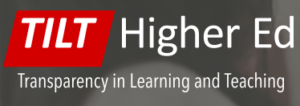- MN ABE Connect
- Archive
- Creating Transparent Assignments
 January 2, 2020
January 2, 2020
Creating Transparent Assignments
Stephanie Sommers, ACES CoordinatorTransparency is a word that we use a lot. We value transparency in government, regulations, policies, and decision-making. The idea of transparency is that it makes things clearer and easier to understand. When it comes to the classroom; however, do we make sure that our assignments and directions are transparent? Are we taking the time to clearly outline the purpose of our assignments, along with the success criteria, for our learners?
 These are some of the questions that I was exploring when I came across the Transparency in Learning and Teaching (TILT) in Higher Education Project (https://tilthighered.com). TILT Higher Ed is a research project that started in 2009 and is currently housed at Brandeis University. The goal of TILT is to help faculty to implement a transparent teaching framework that promotes students’ success.
These are some of the questions that I was exploring when I came across the Transparency in Learning and Teaching (TILT) in Higher Education Project (https://tilthighered.com). TILT Higher Ed is a research project that started in 2009 and is currently housed at Brandeis University. The goal of TILT is to help faculty to implement a transparent teaching framework that promotes students’ success.
The website is a collection of resources, including videos, templates, examples of transparent assignments, and research articles that all have the goal of enhancing student success equitably. Because of the focus on helping learners to better understand an assignment and, in turn, find more academic success, I have added the TILT Higher Ed website to the Learning Strategies section of the ACES resource library.
The TILT framework has three basic components: purpose, task, and success criteria. There are links to short videos about each of these components on the website, as well as links to longer videos about the research behind the project.
Component #1: Purpose
The first component of a transparent assignment is a well-defined purpose that explicitly states both the knowledge and the skills that a learner will gain by doing the assignment, as seen in the template below. The purpose highlights the transferable nature of the knowledge and skills, and describes how they relate to learners’ real lives.
There are several example assignments included with the resources on the TILT website that illustrate the difference between more and less transparent assignments. Example D is from a Communications course, and the assignment focuses on doing an informational interview.
The more transparent example has a clearly stated purpose: “The purpose of this assignment is to help you make an informed decision about the major/career you are considering.” The purpose is then broken into the skills and knowledge that a learner can be expected to build by doing this assignment.
When compared to the less transparent assignment, which does not include a section on purpose, it is easy to see how adding the purpose would benefit learners in two important ways: 1) understanding why they are being asked to do the assignment and 2) understanding how the experience might benefit them in the future. When learners have this information, it provides them with more motivation to spend time thinking about their work.
This is the part of creating transparent assignments that I am most interested in personally, and it’s also the part that has a lot of clear overlap with ACES and standards-aligned instruction in general. Too often, we fall into a trap of thinking that it will be obvious to a learner why or how doing certain tasks will benefit them. We ask our students to write, for example, because we know that having strong written communication skills are important for both college and career readiness. For learners who do not have a great deal of experience with what it looks like to write for work or school, however, we cannot assume that they will naturally value a writing task. If we can help our learners to really understand what skills and knowledge they can gain from doing a writing task, imagine how much more meaningful that task will become.
Component #2: Task
The second component is task, which is the part of an assignment that teachers traditionally spend the most time thinking about and trying to explain. A well-defined task tells learners what to do and how to do it. When learners fully understand what they are being asked to do, they are able to put more of their focus and energy into producing the desired product.
Component #3: Success Criteria
The third component is success criteria. While many teachers do include a checklist or rubric to help learners understand how their work will be evaluated, transparent assignments go beyond this to include an annotated example of a successful response.
The Dalai Lama once said, “A lack of transparency results in distrust and a deep sense of insecurity.” If you agree, I encourage you to take some time and explore the TILT Higher Ed website, especially the section on TILT examples and resources. There is a link to a transparent assignment template that can be used to help ABE teachers at a variety of levels begin to incorporate the transparency framework into their instruction. There is also a useful section on transparent teaching methods that can be found by clicking on About TILT from the homepage and then scrolling down to the bottom of the page and clicking on Transparency Methods under Related Links. The methods are a list of small changes that teachers can make that will result in more transparency in the classroom.
Want to learn more?
I hope I’ve piqued your interest enough to want to learn more. If I have, please consider registering for the upcoming ACES webinar on creating transparent assignments. The webinar will take place on Monday, January 13 from 2:00-3:30. We will dive deeper into all three components of transparency and talk about ways to use some of the TILT resources in our own classrooms. Register on the ATLAS website >>
Newsletter Signup
Get MN ABE Connect—the official source for ABE events, activities, and resources!
Sign UpArticle Categories
- ABE Foundations/Staff Onboarding
- ACES/Transitions
- Adult Career Pathways
- Assessment
- CCR Standards
- Citizenship
- COVID-19
- Cultural Competency
- Digital Literacy/Northstar
- Disabilities
- Distance Learning/Education
- ELA
- Equity/Inclusion
- ESL
- HSE/Adult Diploma
- Listening
- Math/Numeracy
- Mental Health
- Minnesota ABE
- One-Room Schoolhouse/Multilevel
- Professional Development
- Program Management
- Reading
- Remote Instruction
- Science
- Social Studies
- Speaking/Conversation
- Support Services
- Teaching Strategies
- Technology
- Uncategorized
- Volunteers/Tutors
- Writing
